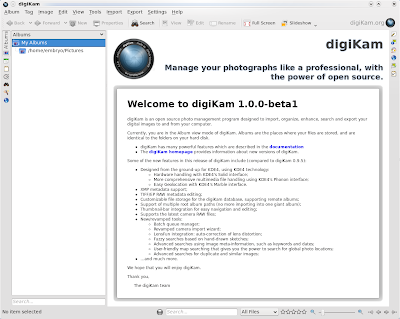digiKam is a free photo management application for KDE, and probably the best alternative to Picasa from Google. digiKam includes many photo retouching and photo manipulation functions, and it allows to organise your collection into albums.
Kubuntu 9.04 comes with version 0.10 for KDE4, but in the first beta of version 1.0 was released on June 9. Here are several easy steps for compiling digiKam from source and installing it on a Ubuntu/Kubuntu Jaunty machine.
1. Install the needed dependencies
In a terminal window, type:
sudo apt-get build-dep digikam
This command will fetch all the needed development libraries and the meta package build-essential, which includes compilation tools.
2. Get the source code
Next, download the source code from the official homepage of digiKam, then uncompress it:
tar -xjf digikam-1.0.0-beta1.tar.bz2
3. Compile and install digiKam
Make sure the current working directory is digikam-1.0.0-beta1, then type the following:
cmake .
make
sudo make install
For the last command you will need the user password. Compilation may take a while, so have patience. Once the installation is over, you can start digiKam by either typing digikam in a terminal window or pressing Alt+F2 and typing digikam in the run box that appears.
digiKam 1.0.0 Beta 1 running in Kubuntu 9.04 Jaunty Jackalope 
digiKam homepage
Download digiKam source from SourceForge.net project page
Source URL: http://ashesgarrett.blogspot.com/2009/06/how-to-compile-and-install-digikam-100.html
Visit ashes garrett for Daily Updated Hairstyles Collection
Kubuntu 9.04 comes with version 0.10 for KDE4, but in the first beta of version 1.0 was released on June 9. Here are several easy steps for compiling digiKam from source and installing it on a Ubuntu/Kubuntu Jaunty machine.
1. Install the needed dependencies
In a terminal window, type:
sudo apt-get build-dep digikam
This command will fetch all the needed development libraries and the meta package build-essential, which includes compilation tools.
2. Get the source code
Next, download the source code from the official homepage of digiKam, then uncompress it:
tar -xjf digikam-1.0.0-beta1.tar.bz2
3. Compile and install digiKam
Make sure the current working directory is digikam-1.0.0-beta1, then type the following:
cmake .
make
sudo make install
For the last command you will need the user password. Compilation may take a while, so have patience. Once the installation is over, you can start digiKam by either typing digikam in a terminal window or pressing Alt+F2 and typing digikam in the run box that appears.

digiKam homepage
Download digiKam source from SourceForge.net project page
Source URL: http://ashesgarrett.blogspot.com/2009/06/how-to-compile-and-install-digikam-100.html
Visit ashes garrett for Daily Updated Hairstyles Collection






